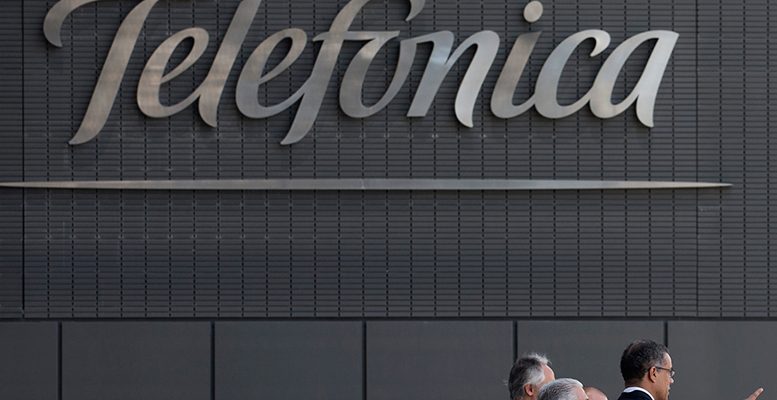On 10 November last, CaraxAlphavalue revived the idea of investing in Telefonica, one of the most international profiles in the telecom sector with nearly 75% of the business outside its home market and a reference point in the Spanish- and Portuguese-speaking markets. Indeed, if this global position allowed to deliver modest organic growth in the early 2010s despite a sluggish European market, it has caused a devaluation of Telefonica’s market cap since 2015 with the collapse of almost all the South American currencies vs the euro.
Since then, the share has resumed more than 10% thanks to the sharp recovery of the telecom sector in December: a catch-up effect as the sector had in the weeks before suffered from the anticipated rise in interest rates. The group may actually worry investors about its still huge debt: c.€48bn at end 2016 (adjusted from long-term investments), corresponding to c.3x EBITDA. Telefonica failed to sell its UK subsidiary O2 for €13.9bn in 2016, the disposal having been blocked by the EC. Floating it as an alternative stumbled on the Brexit vote and Telefonica is now in waiting mode for “alternative strategies to be explored”. As a result, Telefonica has had to cut its dividend to strengthen its balance sheet through organic deleverage: it is now at €0.4 (vs €1.4 in 2010!) but should allow a decrease in net debt of €2bn per year.
Two points of strength: Spain and Brazil
First, Telefonica has a solid base in Spain that sees growth returning. In a world where ultra-fast broadband telecom networks are becoming key assets, Telefonica has sped up the deployment of fibre in Spain to eventually have the most extensive ftth network with a fibre coverage reaching 16.4m premises out of a total c.18m households. This is the most exhaustive coverage in Europe. With these investments, the group should endow itself with a profitable number one spot in Spanish ultra-fast fixed broadband services.
Brazilian hopes
In South America, which is a vector of growth (notwithstanding the currency issue), we have to focus on the country that represents as much as Spain in terms of income: Brazil. This is clearly the second strength of the group. After the acquisition of Brazilian Fixed telco GVT from Vivendi in 2014, Telefonica Brazil has become the largest telecom operator in Brazil with 73m mobile subscribers and 7m households connected to its Fixed broadband network. The group is 69% owned by Telefonica and has a market cap of USD23.5bn.
Telefonica Brazil stock, which had been divided by two in 2015 in $ terms, has climbed by 65% in 2016 and by more than 15% since last November. The BRL has in parallel climbed by nearly 30% vs the euro in 2016 (and by 25% vs the dollar). Carax- Alphavalue’s experts have initiated coverage of Telefonica Brazil with a Buy recommendation and 35% upside (vs 25% for Telefonica).
Telefonica Brazil is perhaps becoming a more mainstream telco (but very solid with its leading position), quite similar to its European peers, but the scope for growth in mobile (driven by smartphones and data) and the significant potential in Fixed broadband and Pay TV still make it a telco which can offer a solid EBITDA growth of 5-7% per year in the next few years…especially if the Brazilian economic context improves.
The group’s strategy consists clearly on focusing on high-end mobile (where the group already has a market share of 35-40% versus 28% for the mobile market as a whole) to increase the ARPU. An improvement in the Brazilian economy should allow Telefonica Brazil to see its mobile revenues grow by 4-5% per year in the next few years with a market share which could improve slightly thanks to its up to date network.
On Fixed (40% of the global revenues), the trend is currently down by 2% per year but less than half of this activity comes from the declining Fixed voice market whose decline is of course partially offset by the growth in broadband activities (+10% per year for Residential broadband).
The company is indeed maintaining its efforts to expand its customer base of 7m households and migrate customers to higher speeds, mainly in fibre (4m households already connected).
The key point is that it is also present on the Pay TV market with a market share of 10%. A market controlled by NET, the main Brazilian cable operator owned by America Movil, with a 50% market share and by Sky (Reduce, UK), owned by AT&T which has a 28% market share. Nonetheless, Pay TV revenues will expand by 15-20% in 2016 due to the growth of the IPTV subscriber base and an ARPU up by 7.5%. A solid performance given the tough economic context, reflecting the potential of IPTV in the future to face cable and the satellite! `
As for EBITDA, the 35% level, already generated in 2012 before the crisis, is well within reach. The EBITDA margin is already expected to be 32.5% in 2016, after two years at 30- 31%, reflecting the company’s focus on higher value clients, commercial rationality and the capture of synergies with the unification of the brands as of April 2016.
Significant 25% upsides
Analysts at CaraxAlphavalue have granted a premium to Telefonica Brazil on the P/E and EV/EBITDA multiples given a growth potential that is greater than that of its European peers. Note Telefonica Brazil avoids borrowing at prohibitive Brazilian rates: its net debt weighs less than a third of its EBITDA and 5% of its market cap.
After the acquisition of GVT, Telefonica Brazil is supposed to be focused on growing on its own, and not to really participate in the sale of Oi which filed for the country’s biggest bankruptcy protection in June 2016. So Telefonica is expected to maintain a relatively strong dividend policy since the listing of its subsidiary allows it to raise funds in the case of acquisitions in Brazil.





